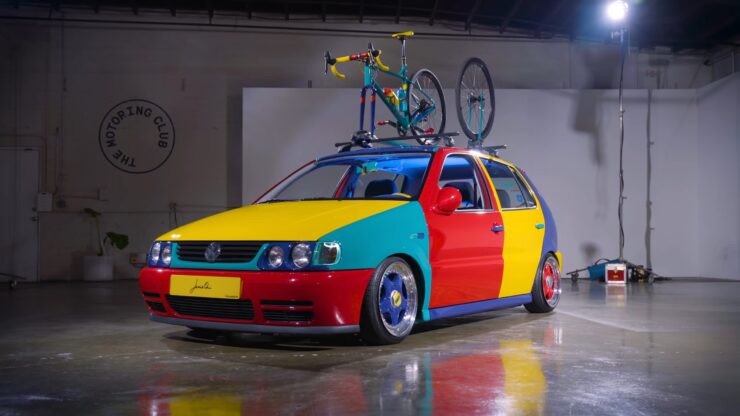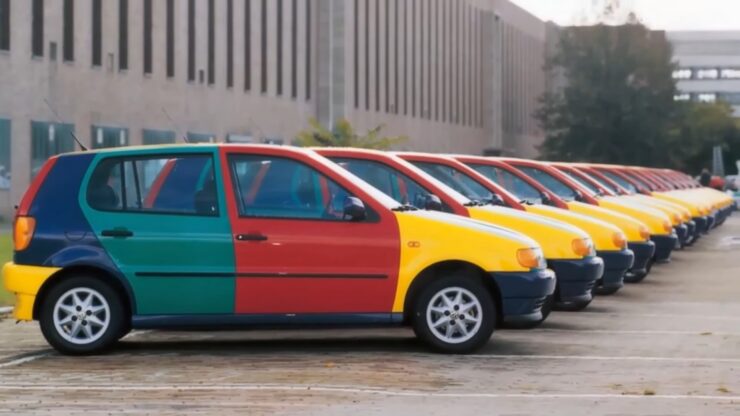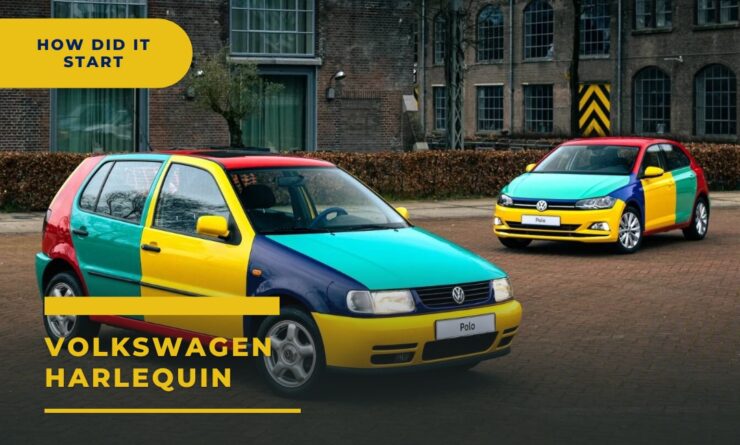You might tilt your head in confusion, pondering why on earth Volkswagen would venture into creating the Harlequin, a car that boasts a medley of colors. Honestly, it’s a fascinating tale. What initially began as a modest marketing gimmick unexpectedly evolved into a unique art form, contrasting starkly with the monochrome hues we often see on the roads today.
Now, imagine cruising down the street in such a vibrant vehicle, turning heads at every corner. It’s not just about the colors; it’s about the audacity of the idea. So, let’s dive deeper. How did Volkswagen come up with such an unconventional color palette in the first place?
The Colorful Saga of the Volkswagen Harlequin
Let’s journey back in time and unravel the vibrant tale of the Volkswagen Harlequin. Interestingly, Volkswagen never initially intended for the Harlequin’s charm to captivate the American audience. The spark for this multi-colored marvel was ignited by a 1964 VW Beetle advertisement. This ad showcased a Beetle with panels of varying colors, emphasizing the ease with which parts could be swapped out.
Fast forward to 1995, Volkswagen of Europe decided to commemorate the launch of their new Polo city car in a rather unconventional manner. They painted it with a patchwork of colors, drawing inspiration from the four primary shades: Pistachio Green, Ginster Yellow, Tornado Red, and Chagall Blue. What was initially planned as a limited edition of 1,000 units soon saw an unexpected surge in demand. Volkswagen ended up producing a whopping 3,100 units for the European market.
This overwhelming response from Europe nudged Volkswagen to introduce the Harlequin Golf to the North American shores. However, the reception in the states was a mix of intense fascination and niche appeal. Only a limited batch of 246 Harlequin Golfs graced the American roads.
Today, more than a quarter-century later, the Volkswagen Harlequin stands as a testament to bold design and rarity. Its limited numbers have made it a sought-after collectible, fetching impressive prices in the market. It’s not just a car; it’s a piece of automotive history that dared to be different.
Intriguing Trivia About the VW Harlequin

The Volkswagen Harlequin, with its patchwork of colors, is undeniably one of the most distinctive cars to ever roll off the production line. But beneath its vibrant exterior lie some fascinating facts that many might not be aware of:
- Decoding the Base Color: Ever wondered about the original color of a Harlequin? A simple glance at the roof, rocker panels, and C-pillar will reveal its secret. These parts retain the car’s base color, be it red, yellow, green, or blue.
- Color Configuration: The base color wasn’t just for show; it dictated the color scheme for the rest of the car. For instance, if the base was red, the front doors would be painted yellow, the rear ones green, and the front grille would sport a blue hue. But here’s the catch – this unique configuration was exclusive to the 264 Harlequins that made their way to North America. Their European counterparts, the VW Polos, all followed a standard color pattern.
- The Harlequin Registry: Passion often leads to creation. Ross Cupples, a die-hard fan of the Volkswagen Golf Harlequin, established a registry dedicated to tracking down these colorful cars in America. It’s a testament to the car’s cult following.
- A Nostalgic Comeback: In a nod to its vibrant past, Volkswagen revisited the Harlequin paint scheme in 2021. However, this was a special edition, with only one such car being produced.
With all these intriguing facts, it brings us to a burning question: Did the Harlequin, with its audacious design, manage to carve a successful niche for itself in the automotive world?
The Challenging Journey of the Volkswagen Harlequin in the States

The Volkswagen Harlequin, with its kaleidoscope of colors, was indeed a bold statement in automotive design. However, its journey in the American market was anything but smooth.
Despite their whimsical appearance and undeniable charm, the Harlequins faced a tough time finding takers in the states. Out of the 264 cars produced, each VW dealership received between zero to two Harlequins. Interestingly, those dealerships that didn’t receive any were considered fortunate.
The Harlequin’s sales performance was underwhelming, to say the least. Only a handful, including enthusiasts like Ross, truly appreciated its unique design. Even its brief moment in the spotlight during the 1996 Olympic games couldn’t boost its popularity. Post the event, some Harlequins were reverted to their original single-color scheme, erasing their distinctive multi-colored identity.
However, the lackluster sales don’t diminish Harlequin’s significance in the automotive world. It’s a testament to Volkswagen’s audacity to challenge the norm and introduce something out of the ordinary.
While it may not have been a commercial success, the Harlequin remains an iconic hatchback, oozing character and personality, unmatched by any contemporary car. It’s a reminder that sometimes, it’s not about the numbers, but the legacy you leave behind.
FAQ
Why was the Harlequin Polo made?
The Harlequin Polo was created as a promotional stunt by Volkswagen to celebrate the launch of the Polo city car. The multi-colored design was inspired by a 1964 VW Beetle advertisement that showcased easily interchangeable parts.
Does VW still make Harlequin?
No, Volkswagen does not currently produce the Harlequin. It was a limited edition model, and while there was a nod to its vibrant past in 2021 with a special edition, it was a one-off production.
How many Polo Harlequins were made?
Originally, Volkswagen intended to produce 1,000 units of the Polo Harlequin for Europe. However, due to higher than anticipated demand, they ended up manufacturing 3,100 units.
What is Harlequin Polo?
The Harlequin Polo is a special edition Volkswagen Polo with a unique multi-colored paint scheme. Each car combined four primary colors: Pistachio Green, Ginster Yellow, Tornado Red, and Chagall Blue.
What is the meaning of Harlequin Volkswagen?
The term ‘Harlequin’ in the context of Volkswagen refers to a unique multi-colored paint scheme used on certain VW models, most notably the Polo and Golf. The design was inspired by the Harlequin characters from Italian commedia dell’arte, known for their checkered costumes.
Which Polo is most powerful?
The Volkswagen Polo GTI is the most powerful variant of the Polo lineup. It comes equipped with a turbocharged engine that offers superior performance compared to the standard models.
What is the biggest Polo engine?
The largest engine in the Volkswagen Polo lineup is found in the Polo GTI, which features a 2.0-liter TSI turbocharged petrol engine.
Final Words
The Volkswagen Harlequin, with its vibrant and unconventional design, stands as a testament to the brand’s willingness to experiment and push boundaries. While its journey in the market had its ups and downs, its legacy remains iconic. The world of automobiles and fashion, as seen with the polo shirt’s origin, is intertwined with history and innovation, reminding us that behind every design, there’s a story waiting to be told.













